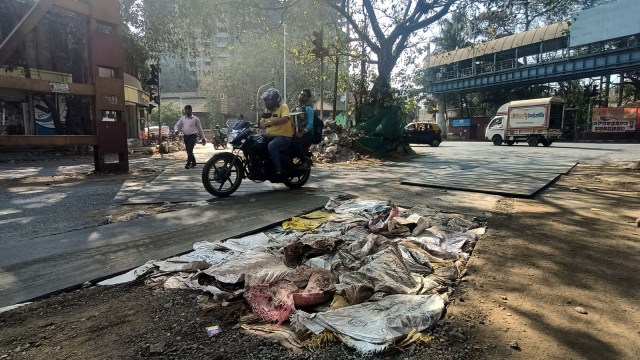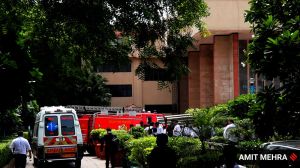BMC Budget today | A year on: Announced last year, big-ticket projects that are yet to take off
Even as the civic body’s budget surpassed the Rs 50,000-crore mark for the first time in its history, several projects which were announced, elemental to the city’s growth, are yet to take off.
 A large pothole near the junction of Barrister Nath Pai Road and Cotton Green railway station. The pothole, reportedly caused by recent roadwork in the area, has been temporarily patched with sacks. (Express photo by Amit Chakravarty)
A large pothole near the junction of Barrister Nath Pai Road and Cotton Green railway station. The pothole, reportedly caused by recent roadwork in the area, has been temporarily patched with sacks. (Express photo by Amit Chakravarty)On Friday, the Brihanmumbai Municipal Corporation (BMC) is all set to unveil the annual civic budget for the financial year 2024 -25. Last year, the civic body — which is also the country’s richest — had rolled out a Rs 52,619.07-crore budget, a jump of 14.52 per cent over the 2022-23 fiscal. Even as the civic body’s budget surpassed the Rs 50,000-crore mark for the first time in its history, several projects which were announced, elemental to the city’s growth, are yet to take off.
Road concretisation project
While announcing the budget last year, the civic body had announced its ambitious plan of making Mumbai pothole-free. The announcement was followed by a Rs 6,000-crore road concretisation project aimed at concretising 397 km of city roads within the next three years.
However, at least as of January 29, work on the concretisation project is yet to see the light of the day. According to sources, no work on the project has commenced yet.
Meanwhile, senior civic officials have said a new tender would be floated at revised rates. “Some of the eligibility criteria of selecting contractors would be revised in the next tender. The project cost may also rise keeping in mind factors like inflation,” an official said.
Last year in November, the BMC had issued a notice of termination of contract to RSIL, one of the five contractors, for failing to even commence work on the project. On January 18, the BMC even told the Bombay High Court that it had also cancelled the fresh tender, worth over Rs 1,362.34 crore, which was issued on December 4 to concretise roads in the island city.
Mired with delays, the road concretisation project, announced in August 2022 — after the Eknath Shinde-Devendra Fadnavis government came to power in July 2022 — to make Mumbai’s roads cement concrete and pothole-free by 2024, remains a distant reality.
14 smog towers
In a bid to curb rising pollution, in the previous budget, the BMC coined and allocated a fund of Rs 25 crore for the policy — Mumbai’s ‘Air Pollution Mitigation Action Plan’ (APMAP), under which the civic body aimed to curb air pollution across various sectors, initiate multi-level monitoring strategy for the city as well as adapt a decentralised planning system for measures to tackle pollution.
As a part of the APMAP, the civic body was eyeing to install 14 smog towers — two towers each in the seven municipal zones of the city — with capacity to purify the air within a one-kilometre radius. According to officials, these 30-ft-high towers would be equipped to cut down the suspended pollutant materials in air by 45%.
One year on, the towers are yet to find ground with the civic body still studying the mechanism and evaluating the best way to implement the system in the city.
Speaking to The Indian Express, an official from the civic environment department said, “We are studying the suitable mechanism for implementation of the system in Mumbai. Setting up a tower requires a lot of space and finding such space in the city is one major concern. Besides, the system also generates a lot of sound. Therefore, we are still studying the best way to implement this system in Mumbai.”
For the record, similar smog towers have been installed in several north Indian cities: Delhi, Gurugram, Lucknow and Chandigarh to curb air pollution levels. However, senior officials pointed out that the failure of the system in curbing pollution in Delhi has led to more extended study of the technology.
Hyper local monitoring system
Within the ambit of the APMAP policy, the BMC also announced a plan to implement the hyper local sensor-based monitoring system. However, the civic body is yet to implement the system.
According to the environment department, a team of experts at IIT-Kanpur are currently studying the feasibility of the technology in Mumbai. “The system of hyper local monitoring systems has already been implemented in Lucknow as well as other cities. Therefore, IIT-Kanpur is conducting a study to check the feasibility of the system and explore the implementation of similar systems,” said a source.
“The funding for this technology has been allocated under the overall mitigation action plan. Since we are still studying the technology, we have not floated any tenders on the same,” they added.
On the question of allocations for air pollution mitigation in this year’s budget, sources from the environment department added, “The implementation of all the technologies which had been announced in the previous year will be carried forward this year. It is unlikely that new announcements will be made this year.”
‘Pedestrian First’ policy
In a bid to declutter urban spaces and provide a better walking experience to Mumbai residents, the BMC, in its budget last year, had announced a ‘Pedestrian First’ policy, under which any road in the city with a minimum width of 9m was proposed to have pedestrian-friendly footpaths. A fund of Rs 200 crore was earmarked to make the city streets more pedestrian friendly.
Speaking during the budget presentation last year, municipal commissioner and state-appointed administrator Iqbal Singh Chahal had said the civic body would carry out a survey of all the roads with minimum width of 9m, following which footpaths will be constructed.
“The process involved removal of hawkers and shanties from the footpaths that would require giving them alternate space. However, the process has been stalled as the Town Vending Committee (TVC) was supposed to help us identify some of the non-hawking zones, which is still pending,” an official said.








